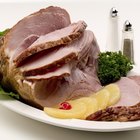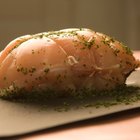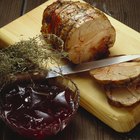
You can tenderize tough cuts of meat in several ways, from the butcher shop's needle-type tenderizer to pummeling it with an old-fashioned meat mallet. For small cuts, one of the most convenient methods uses a dry tenderizing powder that can be rubbed onto the meat directly or incorporated into a spice rub. In most cases, the tenderizer should be left on the meat when it's cooked, to maximize its effect.
What's in the Powder
Enzymes derived from tropical fruits are the active ingredient in the meat tenderizer products you'll find at the supermarket. The most common is papain, which occurs naturally in papayas. Bromelain, derived from pineapples, is also included in some brands. Both work by breaking down the molecular bonds between the muscle fibers, in much the same way your stomach breaks down the meats after you eat them. This reduces the amount of force you need to chew the meat, making it tenderer and more pleasant to eat.
Cold and Slow
The powder must be rubbed over the surface of the meat at least 30 minutes before it's cooked, or the meat can be refrigerated overnight. The tenderizing effect of the enzymes is limited at refrigerator temperatures. Bromelian works better in the cold than papain, but neither has much effect until the meat comes out of your refrigerator. Experiments performed at the University of California and elsewhere have shown that most of the tenderizing effect takes place during cooking, so rinsing off the tenderizer beforehand limits its effectiveness.
The Surface Effect
Papain and bromelian only work at the top surface of the meat, which complicates matters. Usually it's best to cut the meat into small pieces, so there's plenty of surface area for the enzymes to attack. The downside to this is that if you use too much tenderizer, it can give the meat an unpleasantly soft, almost mushy texture. That's one reason why recipes sometimes suggest rinsing off the tenderizer before cooking, though it's better to simply not overuse the powder in the first place.
Getting Inside
Rubbing tenderizer onto a steak or chop that's already been tenderized with a hammer or needle-type tenderizer can be an especially effective approach, because mechanical tenderizing creates lots of tiny channels for the enzymes to penetrate. Rinsing the meat before cooking it has the paradoxical effect of dissolving the tenderizer and helping it find those seams, enabling it to penetrate better. Cooks can do much the same thing by dissolving the tenderizer and using a marinating syringe to inject the tenderizer directly into thick cuts of meat, to soften them from within.
Related Articles

Can You Tenderize Steak With Milk?

What Do You Put on a Steak Before ...
How Long Can You Marinate Meat Before ...

The Effect of Salt on the Tenderness of ...

How Long Can Raw Meat Sit Out?

Can Beef Shoulder Roast Be Sliced and ...

Does Olive Oil Tenderize Meat?

What Happens to Bananas Dipped in Lemon ...
Can I Still Cook a Freezer Burnt Roast?

Does Soaking Elk Roast in Milk Do ...

Can You Marinate Boneless Pork Sirloin ...

Hair Removal With Papaya

Does Boiled Ham Have Nitrites?

How to Brine Pork Loins

Do You Use a Meat Mallet Before or ...

How to Store Cooked Ground Beef

How to Do Corned Pork

How to Cook a Center Cut Pork Loin in a ...
Differences Between Instant & ...

How Long Does It Take for Ground Beef ...
References
- On Food and Cooking: The Science and Lore of the Kitchen; Harold McGee
Writer Bio
Fred Decker is a trained chef and prolific freelance writer. In previous careers, he sold insurance and mutual funds, and was a longtime retailer. He was educated at Memorial University of Newfoundland and the Northern Alberta Institute of Technology. His articles have appeared on numerous home and garden sites including GoneOutdoors, TheNest and eHow.
Photo Credits
Eising/Photodisc/Getty Images